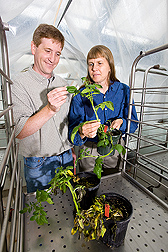Washington, DC, USA
June 16, 2010
 Wild potato germplasm that offers resistance to some major potato diseases has been identified by Agricultural Research Service (ARS) scientists.
Wild potato germplasm that offers resistance to some major potato diseases has been identified by Agricultural Research Service (ARS) scientists.
Geneticists Dennis Halterman and Shelley Jansky pinpointed the resistant wild potato species in studies at the ARS Vegetable Crops Research Unit in Madison, Wis.
Halterman has identified a wild potato species called Solanum verrucosum that contains a gene with resistance to late blight, considered the most destructive disease of potato. The wild species can be crossed with cultivated potatoes, and efforts are under way to move the late-blight resistance gene into the cultivated potato gene pool.
But the scientists aren’t stopping there. They are using S. verrucosum to create a potato that’s resistant to both late blight and early blight, a fungal disease that primarily affects the potato plant’s leaves and stems but, if left uncontrolled, can lead to considerable reductions in yields.
To create the multi-disease-resistant cultivar, the scientists crossed S. verrucosum with another wild potato species that is resistant to early blight, and then crossed the wild potato hybrid with the cultivated potato. They currently have seedlings in the greenhouse waiting to be tested in the field.
Halterman and Jansky are also looking for resistance to Verticillium wilt, another fungal disease that can linger in the soil for up to 10 years. Halterman developed a molecular marker to screen potato germplasm for resistance against this disease, saving the scientists time and effort. They found resistance in the wild potato species S. chacoense and crossed it with the cultivated potato. According to Halterman, this could be a good, durable gene that may hold up over the long term.
The scientists’ studies have been published in Physiological and Molecular Plant Pathology, Molecular Breeding and the American Journal of Potato Research.
Read more about this research in the May/June 2010 issue of Agricultural Research magazine.
ARS is the principal intramural scientific research agency of the U.S. Department of Agriculture (USDA). This research supports the USDA priority of promoting international food security.
Photo: Looking for signs of resistance, geneticists Dennis Halterman (left) and Shelley Jansky examine resistant (being held) and susceptible potato plants that have been inoculated with Phytophthora infestans, the causal agent of late blight. Photo by Stephen Ausmus.
Germoplasma de papa silvestre contiene una clave a la resistencia a enfermedades
Científicos del Servició de Investigación Agrícola (ARS) han identificado germoplasma de una especie silvestre de papa que ofrece resistencia a algunas enfermedades principales de la papa.
Genetistas Dennis Halterman y Shelley Jansky descubrieron la especie silvestre de papa en estudios realizados en la Unidad de Investigación de Cultivos de Hortalizas mantenida por el ARS en Madison, Wisconsin.
Halterman ha identificado una especie silvestre llamada Solanum verrucosum que contiene un gen que confiere resistencia al tizón tardío, el cual se considera la enfermedad más destructiva de la papa. Se puede cruzar la especie silvestre con especies cultivadas de papa, y intentos están en curso para transferir el gen de resistencia al tizón tardío a las papas cultivadas.
Los científicos también están usando S. verrucosum para crear una papa que tiene resistencia a tanto el tizón tardío como el tizón temprano, el cual es una enfermedad fúngica que principalmente afecta las hojas y el tallo de la papa, pero, sin control, puede reducir significativamente los rendimientos del cultivo.
Para crear una papa con resistencia a múltiples enfermedades, los científicos cruzaron S. verrucosum con otra especie silvestre de papa que tiene resistencia al tizón temprano, y luego cruzaron el híbrido silvestre con una papa cultivada. Actualmente tienen plántulas en un invernadero para utilización en pruebas de campo.
Halterman y Jansky también están buscando resistencia a la verticilosis de papa, la cual es otra enfermedad fúngica que puede persistir en el suelo por hasta 10 años. Halterman desarrolló un marcador molecular para evaluar el germoplasma de la papa como parte de la búsqueda para fuentes de resistencia contra esta enfermedad. Los científicos descubrieron resistencia en la especie silvestre S. chacoense y la cruzaron con una papa cultivada. Según Halterman, éste podría ser un gen duradero y útil por muchos años.
Los resultados de estos estudios fueron publicados en las revistas 'Physiological and Molecular Plant Pathology' (Patología Fisiológica y Molecular de Plantas), 'Molecular Breeding' (Crianza Molecular) y 'American Journal of Potato Research' (Revista Americana de Investigaciones sobre la Papa).
Lea más sobre esta investigación en la revista 'Agricultural Research' de mayo-junio del 2010.
ARS es la agencia principal de investigaciones cient íficas del Departamento de Agricultura de EE.UU. (USDA por sus siglas en inglés). Esta investigación apoya la prioridad del USDA de promover la seguridad alimentaria internacional.